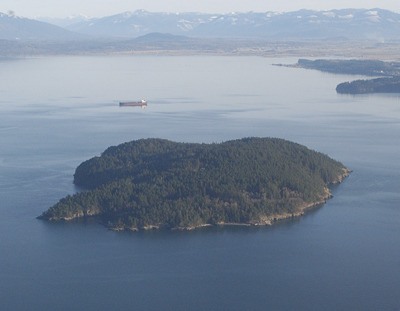Imagine being dropped off on an uninhabited island for a week. Instead of palm trees, white sands and turquoise water, the sky is grey, the wind howls and the rain pours.
Despite the weather, you are in awe of your surroundings and you enjoy working up to seven hours a day, building and reforming trails with your bare hands.
This scenario has been the reality for 12 volunteers, who recently spent a week on Vendovi Island.
“It’s really an amazing island,” said Mark Hoffmaan, one the volunteers. “Trees have been growing here for years, they are absolutely massive, and the canopy is high, and the undergrowth is rich. Plants have really thrived here.”
And when they need a hot shower or if the weather becomes too harsh, they have access to the one house on the property, but other than that it’s just them and the island.
The volunteers are from the Washington Trails Association, which has formed a partnership with The San Juan Preservation Trust to help preserve Vendovi.
SJPT recently purchased the 217-acre island, seven miles north of Anacortes, for $6.4 million. It was made possible by an anonymous benefactor, who provided a $3 million outright gift and bridge funding or “loan” for $3.4 million. The seller was the Fluke family from Seattle. Its patriarch, the late high-tech pioneer John Fluke, bought Vendovi in 1966. The island is only accessible by personal watercraft.
Access to Vendovi Island was prohibited by generations of private owners. The trust intends to strike a balance between conservation and opening the island for education, scientific research and public access. Improvements to the existing trail system will enhance visitor experience and safety, and protect fragile areas with wildlife nesting areas, wildflowers and native grassland.
“It is incredibly rare to preserve an island in its entirety, and particularly an island as untouched as Vendovi,” said Tim Seifert, director of the San Juan Preservation Trust. “We are very fortunate to have the opportunity to do so, and if successful with our fundraising, we will be able to ensure permanent protection and to provide access to all the natural wonders of Vendovi’s 217 acres.”
Last week, from March 24 to 31, WTA volunteers explored and worked on the island, which has six beaches and a harbor protected by a rock breakwater. The volunteers range in age from 22 to 80 years, and mainly hail from Washington state.
“WTA has a consistent and loyal volunteer base and thousands of miles of experience building and maintaining trails in Washington,” said Kathleen Foley, the trust’s program director. “We are excited to work alongside WTA to develop this new island trail system, and we are appreciative of the volunteers who will give a whole week to help us improve the visitor experience on Vendovi Island.”
Volunteer crew leader Arlen Bogaards described the island as mainly “an idyllic island habitat, pristine as it would have been if no one had ever been on the island.”
The volunteers worked aside landscapes adorned with blooming camas and paintbrush flowers and huge patches of thick spongy green moss. Bogarrds said there is about two to three miles of trails that appear to have been built by four-wheel quads to access different beaches.
The crew has been turning those rugged paths into hiking trails by clipping back brush in some areas and removing some organic matter. One of the paths is too steep for walking, so they had to reroute it and turn it into a series of switchbacks. In other areas the paths were reframed to protect areas with fragile plant life.
Hoffmaan, from British Columbia, has had numerous trail building experiences in the Pacific Northwest, but this is his first time with WTA – and his first time working on an island. He said it’s similar to any backcountry experience, whether hiking into the Mount St. Helens wilderness or visiting an island, since they are all remote. He said the difference about Vendovi is that there aren’t any other hikers passing through and because of its size you become intimate with each trail, bluff and beach.
Bogaards hopes that the trails will enhance visitors’ experiences and maybe inspire them to hike or work on other trail systems in the state.
“It’s a unique place, not everyone will be able to get here, but it’s a unique snapshot of what an island could look like if not touched by the hands of man, like what it would have been 100-plus years ago,” Bogaards said.
For more info on WTA, visit www.wta.org. For more info on the trust, visit http://www.sjpt.org/.



